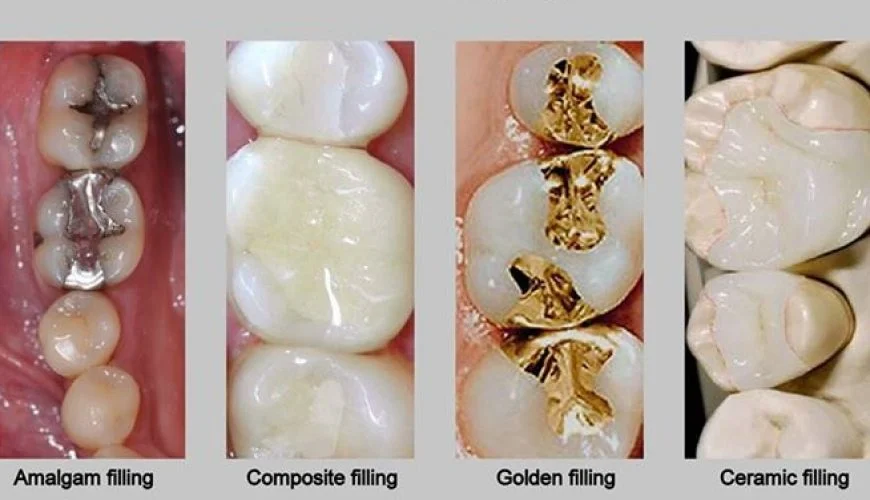How Much Does a Dental Filling Cost? Dental fillings are a common, effective way of restoring damaged teeth caused by cavities or decay. They help maintain good oral health and avoid bad dental conditions. Understanding the different types of dental fillings, their costs, and what influences prices can help you make informed decisions about your dental health.
Understanding Dental Fillings
What Are Dental Fillings?
Dental fillings restore decayed or damaged teeth, generally because of decay or small cracks. The primary function of a filling is to restore the function, shape, and integrity of a tooth. Fillings prevent further damage to the tooth by arresting the progression of the decay into further structures of the tooth. Left untreated in time, the decay may worsen, requiring more complex and costlier procedures like root canals or extractions.
How Do Dental Fillings Work
Getting a dental filling is a process that starts when the dentist looks at the affected tooth to determine the level of decay. Most of the time, local anesthesia is applied to numb the area so that the patient feels nothing during the procedure. A dental drill or laser removes the decayed portion of the tooth, and the area is cleaned to remove bacteria or debris. The filling material is then placed into the cavity and molded to fit the tooth; lastly, it sets using a special light or by waiting for some natural drying.
Dental fillings can be composed of any number of different materials, and each material has its positive features regarding strength, aesthetics, and price. Before making a selection, one must take into consideration the tooth’s location, personal preferences, and budget.
Types of Dental Fillings and How Much Does a Dental Filling Cost?
Amalgam (Silver) Fillings
These amalgam fillings, also known as silver fillings, are one of the oldest options available and prove extremely durable. They are made of a composition of metals among which are mercury, silver, tin, and copper. Because of their hardness, amalgam fillings are frequently used in the posterior teeth like the molars which bear the highest pressure during chewing. These fillings are relatively inexpensive. The price may range from $150 to $300 per tooth. Highly functional, however, amalgam fillings have a silver color and are aesthetically less pleasing for visible teeth.
Porcelain (Ceramic) Fillings (Inlays/Onlays)

Composite fillings are one of the most popular fillings because the filling can be matched closely to the existing tooth color and is ideal for cosmetic use, especially on front teeth. Composite fillings are costlier compared with amalgam; the cost is usually between $200 and $400 per tooth. They also tend to be less hardy than metal fillings and have a lifespan of about 5-7 years.
Gold Fillings
Gold fillings are known for their longevity and durability. They can remain in use for more than 20 years, making them the most durable for filling use. They consist of gold alloy, copper, and some other metals combined for the formulation. These fillings resist corrosion. However, gold fillings are one of the costlier options available and one filling can cost between $400 to $650. This treatment may consist of multiple visits, which increases the cost.
Porcelain (Ceramic) Fillings (Inlays/Onlays)
Porcelain fillings, also known as ceramic fillings or inlays/onlays, are made to match the color of your teeth. They resist stains very well and give a natural appearance. The durability of porcelain is high, and these fillings may last longer than 10 years. Porcelain is the most expensive type; in fact, each tooth could take between $500 and $2,800. The high cost is associated with the specific, complex manufacturing and the time required in creating a custom restoration.
Factors Affecting the Cost of Dental Fillings
Type of Filling Material
The most determining type of filling material is the cost component. Amalgam tends to be the cheapest filling material, whereas porcelain and gold are more expensive since the materials as well as the process of placing them are more complicated.
Location and Size of the Cavity
Fillings on the back teeth, such as molars, are often more expensive simply because they are larger and, hence less accessible. Moreover, the size of the cavity will depend, to some degree the more dentally, cost as a cavity of greater size means it will require more material and be filled up more fully.
Dentist’s Experience and Location

Dental fillings may also depend on the experience and education of the dentist. Those in more significant demand or who have a higher degree qualification will cost more. In addition, where you are can be expensive too; cities or districts that have a high cost of living generally charge more.
Dental Insurance Coverage
Most dental plans will pay for fillings, but typically only to an 80% share after the deductible has been met. This can vary, though, based on what filling is chosen and what specifics the contract for the plan details.
Additional Treatments (e.g., anesthesia, X-rays)
In some cases, other treatments like anesthetics or X-rays may be needed, and this can really run up the total cost of filling.
In addition, sedation options with anxious patients may add to the cost.
How Much Does a Dental Filling Cost?
With Insurance
How Much Does a Dental Filling Cost? With Insurance, Dental fillings can reduce the out-of-pocket expenses for patients when covered with insurance. The cost of an amalgam filling is about an average of $10 to $50. A composite filling can range from $40 to $100 based on the insurance plan.
Without Insurance
How Much Does a Dental Filling Cost? Without insurance, the cost of a filling may be hazy and depends mainly on the material used. Amalgam fillings can be from $150 to $300, composite fillings vary between $200 and $400 per tooth, and gold and porcelain fillings are more pricey: up to $2,800 sometimes for porcelain.
Other Factors That Impact the Cost
A Professional’s Fee
The cost of a dentist’s fee will vary with his experience and reputation. General costs of the whole dental filling procedure also rely on this factor.
Reputation of the Medical Center
Their reputation or state-of-the art technology makes a dental clinic or center more costly in most cases.
Geographic Location and Cost of Living
The expenses of dental clinics vary from one location to another. Places where the cost of life is high will, therefore, have more expensive dental care.
Ways to Save Money on Dental Fillings
Dental Insurance Plans
By using a dental insurance plan, you pay much less for the filling. Most plans pay for 80 percent of the treatment costs once the deductibles are covered
Dental Discount Plans
Dental discount plans may be used to negotiate fillings at reduced fees, hence offering an economic alternative for patients without dental insurance coverage.
Seeking Treatment at Dental Schools

Most dental schools provide very affordable dental care which is performed by supervised students. This is an excellent means of saving on fillings without compromise on quality.
Preventive Care Measures
Preventing cavities is the best way to cut down costs incurred on dental fillings. Brushing, flossing, and regular dental check-ups all contribute to healthy oral hygiene.
Paying for Dental Fillings Without Insurance
How Much Does a Dental Filling Cost by Using Other Options? Other ways are through using CareCredit, dental discount plans, and offering payment plans in case one doesn’t have dental insurance. In some instances, just asking your dental clinic if they might have a payment option or if they can offer any sort of discount can relieve a lot of financial pressure.
The Importance of Dental Fillings
Dental filling contributes much in ensuring that your mouth remains healthy. It will help stop the decay from advancing and ensures structural integrity is kept intact for a tooth. Failure to treat cavities can lead to root canals, tooth extractions, and more expensive restorations.
The Risks of Untreated Cavities
Cavities will further lead to infections, loss of teeth, and even major systemic health issues. In this regard, the cavities must be attended to at an early stage of their development to avoid any complications.
How Long Do Dental Fillings Last?
The duration of dental fillings varies according to the type of material used to make them. Amalgam fillings last approximately 10-15 years, composite fillings around 5-7 years, and gold fillings for more than 20 years if proper care is taken.
Potential Risks and Side Effects of Dental Fillings
Can Dental Fillings Fail?
It can break, crack, or wear away because of poor oral hygiene, untimely brushing, or even bad placement. Regular checkups must be conducted in order for you to ascertain that it is still in good shape.
What to Do If a Filling Fails?
If this is the case, do not hesitate to visit your dentist as soon as possible in order for him to rectify or replace the filling so that more damage does not befall the tooth.
Tips for Maintaining Oral Health and Preventing Cavities
Daily Oral Hygiene (Brushing and Flossing)
Brushing at least twice a day with fluoride toothpaste and flossing once daily can be done to prevent cavities as well as maintain good condition on the fillings.
Regular Dental Check-ups
You will ensure that your dentist tracks your oral health by visiting him/her regularly, six months at times. It keeps the dentist in touch with the progression of oral problems early in the diagnosis process.
Dietary Habits to Prevent Cavities
The development of dental cavities is promoted by foods that contain sugar content and are acidic. A diet rich in calcium and phosphorus will keep your teeth hard.
Frequently Asked Questions
What is a Tooth Filling Made Of?
Tooth fillings can be amalgam (silver), composite (tooth-colored resin), gold, or porcelain.
What Do Teeth Fillings Look Like?
The color of the filling is determined by which material is used. Composite and porcelain fillings are tooth-colored, which means they are virtually the same color as the other teeth in your mouth. Amalgam fillings are silver.
Can Fillings Get Cavities?
Fillings themselves do not cause cavities, but decay can develop around the edges if good oral hygiene isn’t taken care of.
Is a Dental Filling Painful?
Typically, the process is pain-free with local anesthesia, but some patients may experience minor discomfort.
How Long Does It Take to Fill a Cavity?
A regular filling procedure will take about 20 minutes to an hour, depending on the size and location of the cavity.
Can You Fill a Tooth at Home?
Filling a tooth at home is not recommended. Always seek professional dental care for proper treatment.
Summing Up
Dental fillings are essential for maintaining oral health, providing a relatively inexpensive solution to cavities and tooth decay. The cost of a dental filling varies widely depending on factors like the type of material used, the expertise of your dentist, and whether or not you have dental insurance. Understanding how much does a dental filling cost is key to making informed decisions about your oral health.
Preventive care, such as regular brushing, flossing, and dental check-ups, is the best way to avoid the need for fillings in the first place. However, if you do need one, knowing how much does a dental filling cost can help you plan and manage your expenses. Whether you’re opting for an affordable amalgam filling or a more expensive gold or porcelain option, understanding how much does a dental filling cost ensures you are financially prepared.
Dental insurance can significantly reduce your out-of-pocket expenses, but it’s important to review your plan’s coverage to determine how much a dental filling costs under your specific policy. Additionally, exploring payment plans or using options like CareCredit can help make the procedure more affordable for those without insurance. Many patients wonder how much a dental filling costs when considering the long-term care and durability of the filling. With proper care, some fillings can last over a decade, making them a worthwhile investment.
For those looking to save on dental costs, options like dental discount plans and treatment at dental schools are viable alternatives. Asking your dentist about payment plans and negotiating fees can also impact how much does a dental filling cost. Finally, knowing how much does a dental filling cost allows you to weigh your options and choose the best material and treatment approach based on your needs and budget.
In the end, understanding how much does a dental filling cost helps you stay on top of your dental care, ensuring you maintain a healthy smile without breaking the bank.
There is another way to save money and time and to Straighten your teeth with Invisalign.







